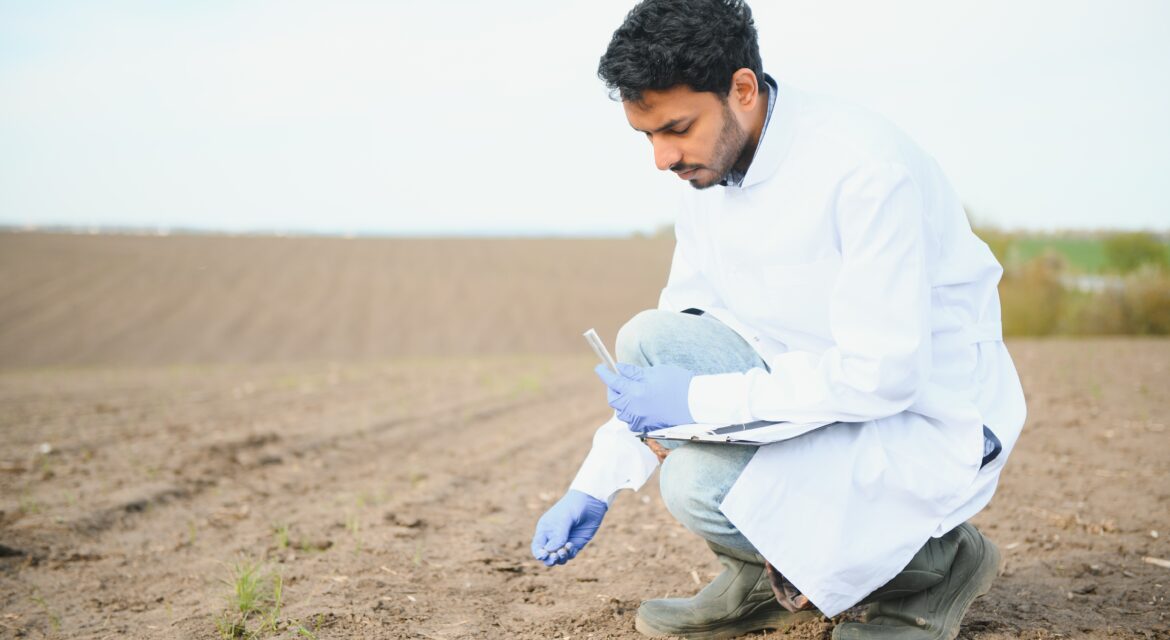No products in the cart.
 19 June 2025
19 June 2025Soil Testing 101: Why It’s Important Before Sowing
The soil is the farmer’s best asset, a living laboratory that has a direct impact on the health and productivity of all crops. Agricultural methods relied on tradition and instinct for centuries. But with the rapid changes of today’s agricultural era, more science is not only desirable but imperative. Even before any single seed falls to the ground, knowing your soil’s specific and ever-changing makeup through accurate analysis is vital. This complete manual will shed light on the significance of soil testing significance, laying out the reasons why it is an indispensable prerequisite to sustainable and fruitful farming businesses in today’s age, with a specific emphasis on the critical role of Soil Health India.
Why Is Soil Testing So Important?
Consider soil testing a thorough check-up of your farm’s most important asset. It provides a valuable diagnostic report, backed by scientific rationale in formulating informed nutrient management decisions. This is a preventive step that prevents both crippling deficiencies and poisonous excesses of vital factors, which are key to unlocking the utmost potential of crops and ensuring long-term ecological balance. The life-changing soil testing importance in today’s agricultural practice cannot be overstressed. Soil testing important knowledge is the key to success in modern agriculture.
Optimizing Nutrient Management
Each crop variety, in various stages of growth, has very particular nutritional needs. Without knowing some of the nutrients already in your soil, you risk ineffective fertilizer use, which is using too much, polluting and wasting the environment, or not enough, with little growth and poor returns. A full soil test provides exact readings of current levels of large macronutrients like Nitrogen (N), Phosphorus (P), and Potassium (K), and micronutrients like Zinc (Zn), Boron (B), Iron (Fe), and Manganese (Mn), which, growers can use to build highly precise fertilizer programs from, and this way the plants are receiving precisely what they desire and when they need it, which some call “spoon-feeding” the crop. This accuracy is not just maximizing the utilization efficiency of nutrient uptake but maximizing healthy growth of plants as well.
Avoiding Nutrient Deficiencies and Excesses
Imbalances of nutrients lead to catastrophic outcomes in crop yields.
Deficiencies are reflected as overt symptoms like less growth, chlorosis (yellowing of leaves), or poor development of fruit, which causes direct yield reductions in severe proportions. On the other hand, too much of some nutrients, despite their apparent positive effects, can ironically destroy plants by inducing toxicity or deficiency induction in other nutrients.
For instance, excessive phosphorus can lead to micronutrients sequestering like zinc. Environmental hazards like leaching, contamination of groundwater by nitrates, and poisonous algal bloom in water bodies (eutrophication) are caused by excessive use of chemical fertilizers, particularly nitrogen. Anticipatory regular soil analysis gives the data needed to create and maintain a balanced healthy nutrient, preventing such risks and pointing out the essential economic and environmental soil analysis significance.
Increasing Crop Yield and Quality
The correlation between healthy, balanced soil and strong plant growth is not in doubt. By properly balancing imbalances of pH which regulates nutrient availability and assures ideal access to all required nutrients, soil testing creates a perfect environment for plants to thrive, leading to measurably increased per-acre yields. Other than quantity, the crop is also greatly improved in quality. Crop planted in soil that is evenly outlined about nutrient composition will generally be well-formed, well-hued, more delicious, and better nourished, and consequently more desirable and, ultimately, more profitable for the producer.
Encouraging Sustainable Agriculture Practice
Firstly, in the era of widespread environmental crises and the plea for responsible management of the planet, demand for soil testing to confirm the sustainable agricultural practices is now more crucial than ever. By allowing proper use of fertilizers, soil testing reduces runoff of nutrients into water bodies by a great extent, in addition to cutting down on pollution of water in the bargain.
Secondly, it prevents the overuse of factory-based fertilizers that are energy-cost to manufacture and result in the creation of greenhouse gases. Well-nourished soil, with testing being at the forefront, offers a robust population of microbes, enhances soil structure, increases water-holding capacity, and captures carbon, all of which ensure maximum long-term soil fertility and climate change adaptation. It’s a base practice to construct an eco-friendlier and climate-resilient ag future. Understanding this aspect of soil testing importance is vital for the planet.
How to Test Soil for Farming
Understanding the underlying “why” is only the beginning. Knowing how to test soil appropriately for agriculture is necessary to get relevant and actionable results. Careful performance of soil sampling will have a direct impact on the validity of your follow-up agricultural decisions.
Taking a Representative Sample
The key to accurate soil testing lies in obtaining a truly representative sample of your field. It is important to collect several random sub-samples (usually 10-20 based on field size and heterogeneity) from multiple locations in a uniform management unit. Avoid odd locations like fertilizer spills, dung piles, moist soil, or areas immediately adjacent to roads or buildings, since these will lead to results becoming grossly skewed. Sample with clean, non-rusting equipment (like a stainless-steel spade, auger, or trowel) from the appropriate depth (usually the top 6-8 inches for most vegetable annuals, deeper with perennials).
Mix these sub-samples after sampling into a solitary composite sample for analysis in a clean plastic pail. Careful labeling with accurate field identification, date, and prior crop history is also necessary to equate results to the right plot and analyze past trends. This is an important step in how to test soil for farming and must not be skipped.
Choosing the Right Test Parameters
Even though a routine soil test will normally include large parameters such as the pH of the soil, organic matter, and the large macronutrients (N, P, K), the needs of your operation, rotation, and dominant soil types within the region may require further testing. Aside from the essentials, also test for secondary macronutrients such as Calcium (Ca), Magnesium (Mg), and Sulfur (S), or micronutrients such as Zinc, Boron, Copper (Cu), Iron, and Manganese if you have targeted suspected deficiencies, grow high-valued crops, or see frequent symptoms.
Cation Exchange Capacity (CEC) is a useful test that gives you vital information regarding your soil’s natural capacity to retain and release positively charged nutrients. Salinity, sodicity, or a few of the heavy metal tests can come in handy in dry or irrigated lands, or suspected industrial contaminations. Your local extension agent, agronomist, or your choice of laboratory will help you identify the most suitable and economical combination of test parameters for your particular farming situation. This informed decision is part of how to test soil for successful farming.
Learning to Interpret Your Soil Test Report
Once we’ve had your samples analyzed in our laboratory, you’ll have a complete soil test report, a snapshot of your soil’s current chemical and physical condition. Reports might appear intimidating at first but usually include amounts of nutrients (usually in a descriptive style in terms of adjectives like “deficient,” “low,” “medium,” “sufficient,” or “excessive”), actual measurements of soil pH, and practical advice for the application of lime or fertilizer to your particular crop. Include units of measurement (for instance, parts per million (ppm), pounds per acre (lbs/acre)). Field-scale, real-time measurement is becoming available to farmers with handheld, portable soil test kits that provide instantaneous decision-making. They both also have the buffering capacity (very important for adequate pH correction) and percent organic matter, two of the most significant indicators of soil health India included. This foundational program has given the necessitates for more data-based agricultural practice across the country.
But the best soil health India is a continuous path that requires constant innovation. Don’t be afraid to call upon the agronomists of the lab or your local extension people; they can offer great help in interpreting the technical information and breaking down tricky recommendations into easy-to-follow, workable plans for your operation. This last step is most critical in the utilization of the complete soil testing significance.
The Future of Soil Health India in India
In a country like India, where the economy’s primary backbone is agriculture and an enormous population is sustained, soil health India India as a top priority is not just a choice but a hard and fast necessity for long-term food safety and farmer prosperity. Government efforts, in particular the Soil Health India Card Scheme, have been instrumental in bringing about democratization of availability of basic soil testing facilities and highly increasing awareness regarding the high soil testing significance among crores of farmers. To truly revolutionize Indian agriculture, we need to promote the large-scale use of more advanced testing methods, along with strong, low-cost, easy-to-use advisory services that respond to the various needs of farmers across regions.
Inductive diffusion of advanced technological innovations has huge possibilities. Portable, handheld soil test kits are making real-time, field-scale measurement accessible, allowing for rapid decision-making. Drone and satellite imaging can offer spatial variability for small fields and large fields with precision application of fertilizers. Using Artificial Intelligence (AI) and machine learning methods can also filter through enormous amounts of soil test data, weather conditions, and crops to offer highly accurate, real-time recommendations, even to techno-phobic farmers. They have the potential to bypass Indian agriculture’s traditional constraints, including fragmented ownerships, variations in farm worker literacy, and logistical difficulties in accessing central laboratories.
Invade Agro Global (IAG) is a key player in this revolution. Through investments in advanced research and development for new agro-inputs and co-creation of scalable soil testing technologies, we seek to equip Indian farmers with the information and knowledge required to maximize their resource use, sustainably increase their productivity, and increase resilience to environmental stresses. Realizing the paramount soil testing significance for increased productivity and profitability underpins our purpose. Embracing such innovations and developing a data-based farm culture will guarantee that the diverse farm culture of India remains vibrant, bringing about sustained productivity and prosperity for generations to come.
[xs_social_share]



